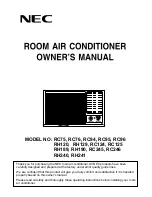
-
57
-
(1)
Tools exclusive for R410A
a) Gauge manifold
• As R410A is characterized by high pressure, conventional tools cannot be used.
• In order to prevent any other refrigerant from being charged accidentally, each port of the manifold has been changed in
shape.
b) Charge hose
• As R410A is characterized by high pressure, the pressure resistance of the charge hose has been increased. The material has
also been changed to an HFC resistant type, and, as in the case of each port of the manifold, the hose cap size has been
changed. Furthermore, for prevention of gas pressure reaction, a charge hose with a valve placed near the cap is also avail-
able.
c) Electronic balance for refrigerant charging
• As R410A belonging to the HFCs features high pressure and high evaporating speed, when R410A is charged by using a
charging cylinder, R410A in the cylinder cannot be kept in a liquefied state and gasified refrigerant bubbles in the charging
cylinder, it becomes difficult to read values. Therefore, it is advisable to adequately use an electronic balance for refrigerant
charging.
• An electronic balance for refrigerant charging has higher strength due to its structure with four points of support for refrig-
erant cylinder weight detection. As the charge hose connecting part has two ports-one for R22 (7/16 UNF 20 threads per
inch) and the other for R410A (1/2 UNF 20 threads per inch) - it can also be used for charging the conventional refrigerant.
• Two types of electronic balance for refrigerant charging are available - one for 10kg cylinder and the other for 20kg cylinder.
Electronic balance for 10kg cylinder
precision ± 2g
Electronic balance for 20kg cylinder
precision ± 5g
• Refrigerant is charged manually by opening/closing the valve.
d) Torque wrench (for nominal diameters 1/2 and 5/8)
• Along with changes in flare nut sizes for enhanced pressure resisting strength, torque wrenches for R410A differ in opposite
side size.
Table 11. Differences between conventional high/low pressure gauges and those for R410A
Conventional gauges
Gauges exclusive for R410A
High pressure
-0.1~3.5MPa
-0.1~5.3MPa
gauge (red)
-76 cmHg~35 kgf/cm
2
-76 cmHg~53 kgf/cm
2
Compound
-0.1~1.7MPa
-0.1~3.8MPa
gauge (blue)
-76 cmHg~17 kgf/cm
2
-76 cmHg~38 kgf/cm
2
Table 12. Differences in port size between conventional manifold and that for R410A
Conventional manifold
Manifold for R410A
Port size
7/16 UNF
1/2 UNF
20 threads per inch
20 threads per inch
Table 14. Differences between conventional wrenches and those for R410A
Conventional torque wrench
Torque wrench for R410A
For 1/2 (opposite side
24mm
×
55N·m
26mm
×
55N·m
×
torque)
(550 kgf·cm)
(550 kgf·cm)
For 5/8 (opposite side
27mm
×
65N·m
29mm
×
65N·m
×
torque)
(650 kgf·cm)
(650 kgf·cm)
Table 13. Differences between conventional charge hose and that for R410A
Conventional charge hose
Charge hose for R410A
3.4 MPa (34 kgf/cm
2
)
5.1 MPa (51 kgf/cm
2
)
17.2 MPa (172 kgf/cm
2
)
27.4 MPa (274 kgf/cm
2
)
Engineering material
NBR rubber
HNBR rubber
internally coated with nylon
Cap size
7/16 UNF
1/2 UNF
20 threads per inch
20 threads per inch
Pressure
resistance
Normal pressure
Breaking pressure








































